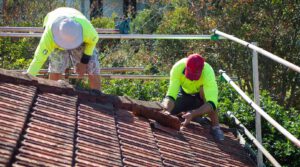Roofing installs and repairs a wide range of roofing materials. Some common types of residential roofing include shingle, tile, and metal.
A shingle is a flat piece of wood, clay, slate, or other material laid in overlapping rows to cover a structure’s roof. In the past, shingles were often made of cut turf, which provided good insulation and moderated building temperatures.

Throughout history, people have used various materials to cover and protect their shelters from the elements. These early roofing materials included woven lattices of sticks and straw, thatched mud or wood, and stone structures. More recently, modern construction has allowed for the development of a wide range of roofing products that meet specific functional, aesthetic and cost requirements for homes in various locations.
The most common roofing materials are shingles and tiles. These are available in a huge selection of shapes, sizes and colors, allowing for homeowners to create a unique roof that complements the overall style of their home. These roofs are also quite durable and can withstand the elements without much maintenance.
Another option for residential roofing is the membrane system. This system is composed of large sheets of waterproof material that are fused together at the joints. This type of roofing is ideal for low-sloped or flat roofs and is typically used over garages or sheds. The most common membrane systems include rubber, thermo-polyolefin (TPO), and PVC.
For a more traditional look, many homeowners choose to use slate or tile roofing. These natural stone products are not only aesthetically appealing but can withstand the harshest weather conditions. However, they are also more expensive than other roofing options.
Roll roofing is another affordable option for low-sloped or flat roofs. It consists of large rolls of asphalt material that are topped with mineral granules. This type of roofing is fairly easy to install and has a lifespan of about five to ten years.
Some other roofing materials include wood shakes, shingles, concrete and metals. Wood shingle roofs can be made from various types of hard and soft woods, including eastern white cedar, red cedar, and western red cedar. These are a popular choice for homeowners because they offer a wide range of color and texture, and can add to the overall curb appeal of the structure. Concrete roofs can be made from a mixture of cement and stone, or can be reinforced with fiberglass. Finally, metal roofing can be made from a wide range of different alloys and is suitable for high-sloped or flat roofs.
A roof is a complex structure that shields the house or building from rain, snow, sunlight, and wind. A roof can be flat or pitched, vaulted, domed, or a combination of these forms. It can also include hip and ridge vents, drip edges, and flashing, all of which serve various purposes in preventing leaks. Installing or re-roofing is a major home improvement project that requires careful planning and professional installation. Before hiring a contractor, ask for references, proof of licenses and insurance, and the manufacturer’s credentialed contractors list. Ask your homeowners insurer for recommendations as well. A quality roof protects the house and increases its value. It’s an investment worth making.
Proper attic ventilation removes moisture and heat, preserving the integrity of the roof deck and insulation, and reducing energy costs.
As much as any part of the building exterior, a roof takes the brunt of assault from wind, rain, snow, bitter cold, intense heat, and other environmental insults. As such, it is critical that it is maintained properly to ensure a long service life. The maintenance procedures include a general housekeeping survey, which is best done by qualified roofing mechanics. The survey should cover the following items:
Drains, scuppers, gutters and downspouts should be cleaned regularly to avoid accumulation of debris that restricts drainage, accelerates membrane deterioration and poses a potential puncture hazard from sharp edges or movement by wind. Trees and other vegetation that overhang the roof should be trimmed to eliminate the danger of branches falling on the roof during storms.
Joints and seals should be examined for evidence of physical damage or environmental deterioration. This can usually be accomplished by a thorough visual examination, but when in doubt, water testing should be performed to determine the presence of leakage.
In addition, all vents and skylights should be checked to make sure they are securely sealed, and flashing — the material around chimneys and where roof planes meet — should be checked to ensure it isn’t cracked or in disrepair, which can also cause leaks. Any areas that require re-caulking should be attended to immediately. Caulking is usually easily done by qualified roofing mechanics.
Before starting roof repairs, a professional roofing crew would take the time to inspect the current state of the roof. This involves climbing inside the attic or crawl space and getting a good look at things. This is the best way to find issues that might not be visible from the ground. Damp stains, peeling paint and standing water are all red flags.
During the inspection, the roofer would check the flashing for any cracks or holes. These are often caused by improper installation or the use of cheap materials. It takes a while for these problems to show up, so conducting regular roof inspections is the best way to catch them.
The underlayment is also inspected to ensure it’s still in good condition. This is typically made from plywood or oriented strand board (OSB), and it’s designed to protect the roof against moisture, hail, wind, snow and other elements.
If the underlayment is damaged, it must be replaced. This can be done during a repair or re-roofing, but re-roofing would require removing the existing shingles. This can be costly, and it voids the warranty on the new shingles. It’s also a less attractive option, since the second layer of shingles tends to curl up at the edges and may not match the ridges and valleys of the existing shingle.



